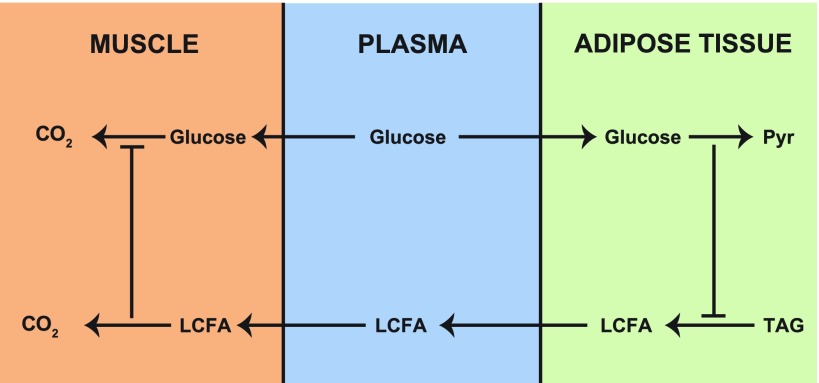The Randle Cycle reveals how you can supercharge fat loss by switching your body's fuel source from glucose to fat. When you adopt a carnivore diet, you're fundamentally rewiring your metabolic engine.
This strategic nutritional approach transforms how your body processes energy, making weight loss more efficient and sustainable. Stick around, and you'll uncover the science behind this metabolic transformation.
Carnivore Diet: Your Body's Natural Metabolic Switch

Imagine your body as a complex energy management system, constantly deciding which fuel to burn for ideal performance. Your metabolic flexibility determines how efficiently you can switch between glucose and fatty acids, a process governed by the Randle Cycle.
This complex mechanism acts like a metabolic switch, allowing your body to choose between different energy sources based on availability and nutritional intake.
When you consume a standard American diet high in fat and carbohydrates, your body has to rely heavily on glucose, reducing your fat oxidation capacity. This can lead to decreased insulin sensitivity and metabolic inefficiency.
Conversely, a carnivore diet fundamentally changes this dynamic by eliminating carbohydrates and forcing your metabolism to prioritize fat as the primary fuel source. The change toward fat metabolism triggers ketosis, where your liver produces ketone bodies that provide an alternative energy pathway.
Regular exercise can enhance this metabolic flexibility, improving your body's ability to shift between fuel sources more smoothly.
By understanding how the Randle Cycle operates, you can appreciate how dietary choices directly impact your metabolic performance, potentially offering a more efficient approach to energy utilization and overall metabolic health.

The Randle Cycle's enzyme interactions play a crucial role in determining how efficiently the body can metabolize different fuel sources, highlighting the intricate biochemical processes underlying dietary metabolic adaptation. The higher protein and fat content can potentially optimize metabolic switching by reducing insulin fluctuations and promoting more stable energy metabolism.
How Carnivore Diet Reprograms Your Metabolic Engine

The Randle Cycle's complex metabolic dance reveals how your body can dramatically reshape its energy utilization patterns through strategic dietary choices.
By understanding how fuel selection works, you'll discover a powerful mechanism that determines how efficiently your body burns fat and processes nutrients.
Hormonal regulation of metabolism plays a critical role in this intricate process, demonstrating how insulin and other hormones directly influence substrate utilization.
When you reduce carbohydrate intake, your metabolic machinery begins to shift dramatically. Instead of relying on glucose as the primary fuel source, your body becomes increasingly adept at oxidizing fat.
This change isn't just a simple switch; it's a sophisticated adaptation that prioritizes energy production based on available substrates.
Your metabolic flexibility improves as you deviate from the standard American diet. The Randle Cycle demonstrates that by minimizing insulin spikes and reducing carbohydrate consumption, you can enhance fat burning capabilities. Your mitochondria become more efficient at converting fatty acids into energy, leading to improved metabolic health.
This metabolic transformation doesn't happen overnight. It requires consistent dietary modifications and an understanding of how nutrient availability triggers specific metabolic pathways. Research indicates that carnivore diet adaptation can accelerate this metabolic reprogramming by providing a consistent, high-protein, low-carbohydrate nutritional environment.
The Carnivore Advantage: Maximizing Fat Oxidation

Metabolic precision defines the elaborate process of fat burning within the body's complex energy systems. When you consume a fat focused diet like with carnivore, your body shifts its metabolic machinery to prioritize fat oxidation. Mitochondrial acetyl-CoA ratios demonstrate how elevated substrate concentrations can fundamentally alter metabolic substrate preference.
The Randle Cycle plays a vital role in this transformation, enabling your body to efficiently switch between glucose and fatty acid utilization.
The metabolic adaptation mechanisms highlight the body's remarkable capacity to rapidly respond to dietary changes, optimizing energy substrate utilization.

During fat burning, your metabolic pathways produce molecules like acetyl-CoA and NADH, which strategically inhibit glucose metabolism. This process creates a metabolic environment that favors fat utilization.
Increased citrate production further suppresses glucose metabolism by affecting key enzymes like pyruvate dehydrogenase and phosphofructokinase-1.
Your body's remarkable adaptability allows it to respond to dietary changes through allosteric regulation and reversible phosphorylation. Hormonal influences, especially insulin levels, greatly impact this metabolic switching.
By reducing net carbohydrate intake, you trigger key metabolic adaptations that enhance fat oxidation for consumed and body fats.
The Randle Cycle fundamentally demonstrates how your body becomes more metabolically flexible, efficiently converting dietary fat into energy. This mechanism not only supports fat loss but also helps begin the process of improved insulin sensitivity, offering a compelling metabolic advantage over traditional high-carbohydrate dietary approaches.
Carnivore Diet Metabolic Advantages

Shifting from fat burning mechanisms, carnivores metabolic advantages emerge as a powerful nutritional strategy. The diet's unique approach triggers the Randle Cycle which sets it apart from traditional eating patterns.
Your metabolic advantages include:
- Enhanced insulin sensitivity by dramatically reducing carbohydrate intake
- Increased fat oxidation through strategic nutritional manipulation
- Improved hormonal regulation supporting sustainable weight management
The carnivore diet's high-fat, high-protein composition activates critical metabolic pathways.
You'll experience reduced insulin fluctuations, which directly supports fat burning and helps prevent energy storage as body fat.
Why Standard Diets Fail: The Carnivore Solution
Nutritional deficiency haunts the Standard American Diet (SAD), creating a terrain of chronic health challenges that demand immediate transformation. You're likely consuming ultra-processed foods that strip essential nutrients from your diet, leaving your body vulnerable to metabolic disruptions.
To overcome these problems, you'll need to adopt carnivore while strategically restructure your shopping and nutritional intake. Incorporate more ruminant proteins and fats to address critical vitamin and mineral deficiencies.
Carnivore Diet: Mastering Metabolic Efficiency

Release your body's peak performance by strategically aligning energy pathways through intelligent dietary choices. By understanding how your metabolism processes nutrients, you'll maximize energy application and support sustainable weight management.
Your body's energy optimization depends on three essential factors:
- Macronutrient balance - prioritizing balanced fat and protein while minimizing carbohydrate intake to facilitate metabolic efficiency.
- Ketosis adaptation - training your metabolism to employ fat as the primary energy source.
- Hormonal response - improving testosterone levels and reducing inflammation through strategic nutrient selection.
The carnivore diet offers a powerful approach to metabolic optimization by eliminating energy-depleting foods and replacing them with nutrient-dense animal proteins.
Your body will become more efficient at converting dietary and stored fat into usable energy, supporting body fat loss and improved physical performance.
Ultimately, optimizing nutritional energy pathways isn't just about losing weight—it's about transforming your metabolic potential.







